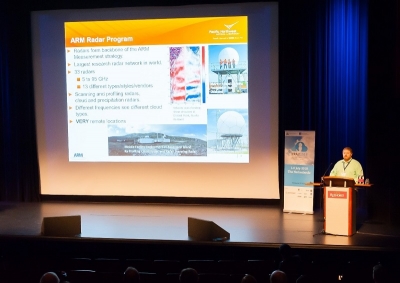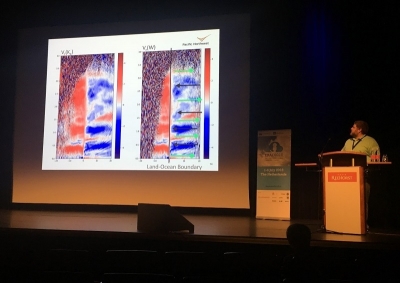In the Netherlands, a Touch of the Arctic
Published: 20 August 2018
A European radar conference includes a briefing on millimeter wave cloud radars emplaced in far-northern Alaska

On most days, radar engineer and computational scientist Joseph Hardin is at his desk at Pacific Northwest National Laboratory (PNNL) in Washington state.
In early July 2018, however, Hardin found himself in front of an audience of 800 radar experts in Ede, Netherlands, where he delivered a keynote address on millimeter wave radars in far-northern Oliktok Point, Alaska, on the shores of the frigid Beaufort Sea.
The Oliktok site is part of one of the world’s most remote observatories, managed by the U.S. Department of Energy’s (DOE) Atmospheric Radiation Measurement (ARM) user facility.
Hardin was at the 10th European Conference on Radar in Meteorology and Hydrology (ERAD), the latest iteration of a biennial event that “moves around Europe demonstrating the cutting edge in radar and radar meteorology,” he says. “ERAD provides a platform to transfer knowledge from research into operational use.”
Every other year, the conference brings together students, research scientists, radar engineers and operators, and end users of radar data from around the world.
Hardin, a member of the ARM Radar Engineering and Operations Group, is an expert in electrical engineering, climatology, and remote sensing. His conference presentation was on using millimeter wavelength cloud radars in arctic environments.
In October 2013, ARM deployed a mobile facility to Oliktok Point, which is part of ARM’s North Slope of Alaska (NSA) atmospheric observatory. In 2016, ARM added further instrumentation at Oliktok to better observe aerosols (tiny cloud-forming particles).
Overall, ARM’s Oliktok mission is to study high-latitude clouds and radiative processes in a part of the world where atmospheric changes are happening up to twice as fast as most other regions.
ARM millimeter wave radar systems—often distinguished by an antenna that looks like a giant rooftop hot tub—peer into clouds to gauge their extent and composition at millimeter wavelengths.
Among other things, the zenith-pointing radars help determine cloud boundaries: that is, where the tops and bottoms of clouds are. Meanwhile, the scanning cloud radars provide spatial context for these measurements.
The same devices also have a Doppler capability, which allows scientists to determine the velocities of a cloud’s constituent components. Beyond Doppler, these radars use more advanced techniques, such as polarimetry, to provide information on the shape and types of particles in the atmosphere.
ARM Arctic Radars Reveal the Unexpected

Against a dramatic backdrop—“the largest screen I have ever used for a presentation,” says Hardin—and with a carousel of large-font slides, he used the keynote to demonstrate the utility of such radars in the Arctic.
ARM has many instruments at Oliktok, including scanning and vertically pointing cloud radars, Raman and micropulse lidars, a ceilometer, eddy correlation flux and balloon sounding systems, an atmospheric emitted radiance interferometer, and a suite of all the standard meteorological measurements.
Among Oliktok’s wealth of mobile facility instruments are two multifrequency millimeter wave cloud radars.
Until September 2017, Oliktok hosted a scanning Ka/W-band fully polarimetric radar and a vertically pointing polarimetric Ka-band radar. As part of a site reorganization, the scanning radar has since been relocated to an NSA site in Barrow (officially known as Utqiaġvik).
Taken together, Oliktok’s radars have high sensitivity and high spatial resolution—qualities that allow them to provide high-resolution observations of cloud processes. Combined with the unique location, the radars have provided scientists with a new look at the internal structure of arctic clouds.
“I focused on ‘unusual’ cases,” says Hardin of his keynote—ones that “demonstrated how the unique capabilities of our cloud radars at Oliktok could show phenomena that were not expected to be present in arctic environments.”
These unusual cases include “what we believe are arctic mammatus,” he says, “which are more commonly associated with lower-latitude weather.” Mammatus clouds are characterized by pouch-like structures hanging at the cloud base.
His address also provided the audience with a few surprising examples of arctic cloud structure and dynamics.
“We showed many examples of complex internal turbulence structures in the clouds,” says Hardin. “While the arctic community has seen these before, I think the complexity was surprising to researchers with less experience with arctic weather.”
The presentation had more than two years of co-located radar data behind it, as well as a longer data set from just Oliktok’s vertically pointing radar. That rich collection of measurements means that scientists are beginning to see emerging patterns and statistics regarding cloud structures.
Hardin also outlined future activities for collecting and analyzing arctic radar data.
“ARM has started organizing engineering resources to strengthen our arctic site in Utqiaġvik, Alaska, along the northern coast,” he says. “Andrei Lindenmaier (PNNL radar engineer) has been leading an effort to install the Oliktok scanning radar at Utqiaġvik, as well as improving the functioning of the current radars.”
Beyond the Alaska sites, adds Hardin, “ARM is launching a wide array of high-latitude campaigns.”
These include Multidisciplinary Drifting Observatory for the Study of Arctic Climate (MOSAiC), slated to start in September 2019, and Cold-Air Outbreaks in the Marine Boundary Layer Experiment (COMBLE), which is scheduled to begin in January 2020.
Showing Off ARM Data

Ede is a Dutch city known for fruit juice, flowers, and a pillow factory—not for the latest in world radar technology.
From July 1 to 6, 2018, however, it was the place to be if you are interested in object-detection systems that use radio waves.
Other authors helped Hardin in his role as lead author of the overview presentation on millimeter wave cloud radar observations at ARM’s Oliktok Point site. Those collaborators included:
- senior author and ARM Radar Engineering Lead Nitin Bharadwaj, PNNL
- ARM radar translator Scott Giangrande, Brookhaven National Laboratory in New York
- Todd Houchens, Sandia National Laboratories in New Mexico
- Robert Houze, PNNL and University of Washington
- Matthew Shupe, National Oceanic and Atmospheric Administration (NOAA) and Cooperative Institute for Research in Environmental Sciences (CIRES)
- Christopher Williams, University of Colorado, Boulder.
Hardin called out Williams for his clutter-removal improvements to the Oliktok data quality.
At the conference more broadly, Hardin was joined by other scientists, engineers, and data users linked to ARM—as well as by scientists whose work is funded through DOE’s Atmospheric System Research (ASR) program.
Among the attendees were American and European ARM and ASR affiliates:
- Alessandro Battaglia, University of Leicester, U.K.
- Bharadwaj, Bradley Isom, and Alyssa Matthews, PNNL
- Scott Collis and Zach Sherman, Argonne National Laboratory in Illinois
- Robert Jackson, Stanford University
- Stefan Kneifel, University of Cologne (Germany)
- Matthew Kumjian and Robert Schrom, Pennsylvania State University
- Sergey Matrosov, NOAA, Boulder, Colorado
- Alexander Ryzhkov, NOAA National Severe Storms Laboratory, Norman, Oklahoma
- Marcus van Lier-Walqui, Columbia University and NASA Goddard Institute for Space Studies
- Venkatachalam Chandrasekar, Colorado State University.
During the conference’s six days, “ARM data were used in many of the talks and presentations,” says Hardin.
Particularly well represented, he adds, was Biogenic Aerosols ̶ Effects on Clouds and Climate (BAECC), a 2014 ARM field campaign in remote wintery Finland. Scientists there used radars and other instruments to capture more than seven months of data on the seasonal variability of biogenic aerosols in a boreal environment.
BAECC has continued to inspire a blizzard of strong papers.
The ARM Climate Research Facility is a DOE Office of Science user facility. The ARM Facility is operated by nine DOE national laboratories, including Pacific Northwest National Laboratory.
Keep up with the Atmospheric Observer
Updates on ARM news, events, and opportunities delivered to your inbox
ARM User Profile
ARM welcomes users from all institutions and nations. A free ARM user account is needed to access ARM data.


















